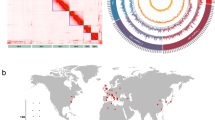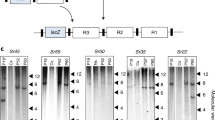Abstract
POPULATIONS of the peach-potato aphid Myzus persicae (Sulzer) heterozygous for a particular translocation between autosomes 1 and 3 were first discovered in glasshouses in Great Britain1. A similar or identical trans-location was subsequently found to occur commonly in field populations of M. persicae in many parts of the world (Table 1). In tropical and warm temperate regions M. persicae is permanently thelytokous2, but survival of trans-location heterozygotes in the sexual cycle of the aphid, where a translocation would be expected to impose a severe genetic load3, has also been demonstrated4. Considerable resistance to organophosphorus insecticides is common in glasshouse populations of M. persicae5, and laboratory clones originating from glasshouses and isolated for such resistance are invariably translocated. A link between the translocation and organophosphorus resistance has been suspected, as this could provide the selective advantage which would explain the worldwide occurrence of translocation heterozygotes and their survival in the breeding system. However, no information has been available on the comparative resistance of translocated and normal aphids from most parts of the world. Populations with moderate organophosphorus resistance that appeared in the field on sugar beet in England in 1974 (ref. 6) had the normal karyotype, as also did a resistant clone originating from peaches in France in 1968. Now we report evidence that directly implicates the translocation in the organophosphorus resistance of M. persicae.
This is a preview of subscription content, access via your institution
Access options
Subscribe to this journal
Receive 51 print issues and online access
$199.00 per year
only $3.90 per issue
Buy this article
- Purchase on Springer Link
- Instant access to full article PDF
Prices may be subject to local taxes which are calculated during checkout
Similar content being viewed by others
References
Blackman, R. L. & Takada, H. J. Ent. A 50, 147–156 (1975).
Blackman, R. L. Bull. ent. Res. 63, 595–607 (1974).
White, M. J. D. Animal Cytology and Evolution 3rd edn (Cambridge University Press, Cambridge 1973).
Blackman, R. L. & Takada, H. Genetica 47, 9–15 (1977).
Gould, H. J. Pl. Path. 15, 109–112 (1966).
Devonshire, A. L. & Needham, P. H. Proc. 8th Br. Insecticide Fungicide Conf. 1, 15–18 (1975).
Ozaki, K. & Kassai, T. Entomologia exp. appl. 13, 162–172 (1970).
Beranek, A. P. Entomologia exp. appl. 17, 129–142 (1974).
Blackman, R. L., Devonshire, A. L. & Sawicki, R. M. Pesticide Sci. 8, 163–166 (1977).
Beranek, A. P. & Oppenoorth, F. J. Pesticide Biochem. Physiol. 7, 16–20 (1977).
Blackman, R. L. Chromosoma 56, 393–408 (1976).
Baker, W. K. Adv. Genet. 14, 133–169 (1968).
Hurkova, J. Acta ent. bohemoslov. 68, 372–376 (1971).
Dunn, J. A. & Kempton, D. P. Entomologia exp. appl. 9, 67–73 (1966).
Boness, M. & Unterstenhofer, G. Z. angew. Ent. 77, 1–19 (1974).
Author information
Authors and Affiliations
Rights and permissions
About this article
Cite this article
BLACKMAN, R., TAKADA, H. & KAWAKAMI, K. Chromosomal rearrangement involved in insecticide resistance of Myzus persicae. Nature 271, 450–452 (1978). https://doi.org/10.1038/271450a0
Received:
Accepted:
Issue Date:
DOI: https://doi.org/10.1038/271450a0
This article is cited by
-
Microsatellite variation in cyclically parthenogenetic populations of Myzus persicae in south-eastern Australia
Heredity (2002)
-
Chromosomal location of the amplified esterase genes conferring resistance to insecticides in Myzus persicae (Homoptera: Aphididae)
Heredity (1995)
-
Rapid response to selection for increased esterase activity on small populations of an apomictic clone of Myzus persicae
Nature (1980)
-
Enzyme variability in populations of aphids
Theoretical and Applied Genetics (1980)
-
Insecticide-resistant Myzus persicae as an example of evolution by gene duplication
Nature (1979)
Comments
By submitting a comment you agree to abide by our Terms and Community Guidelines. If you find something abusive or that does not comply with our terms or guidelines please flag it as inappropriate.



